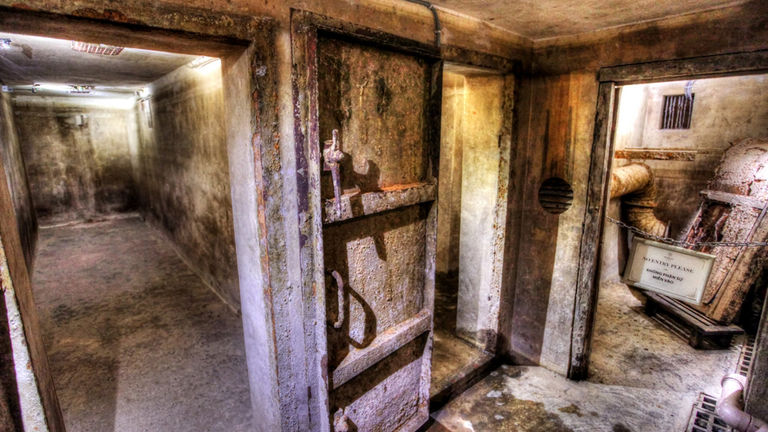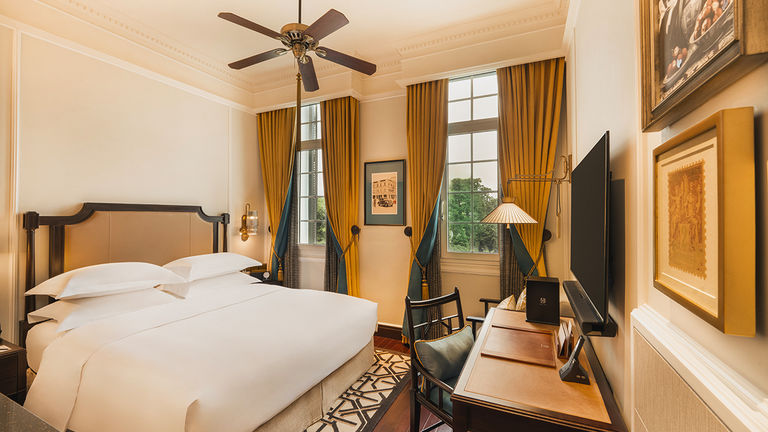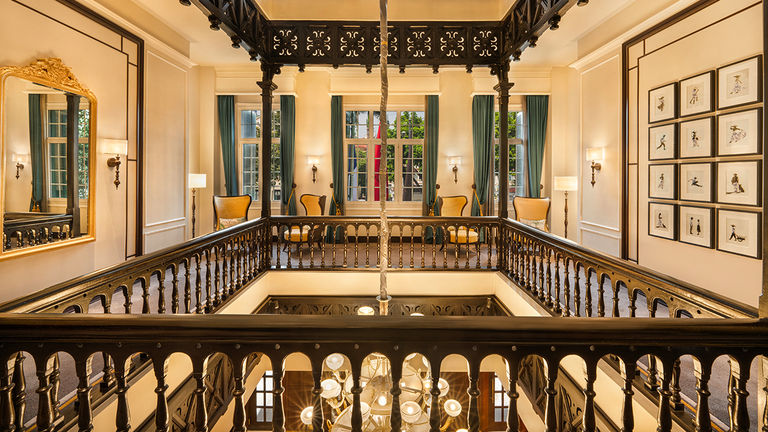During the 1972 Christmas bombings of the Vietnam War, American folk singer Joan Baez sheltered in an underground bunker 15 feet beneath the Thong Nhat Hotel in Hanoi’s Old Quarter, as air raid alarms filled the streets above.
Baez, who was a guest of the hotel at the time, was inspired to write her song “Where Are You Now, My Son?” while sheltering in place, huddled next to a distraught mother weeping for her son. Although it was sealed up shortly after the end of the Vietnam War, the hotel’s bomb shelter was unearthed 40 years later at the now Sofitel Legend Metropole Hanoi, during a renovation of the poolside Bamboo Bar.
A central component of the hotel experience — with complimentary hard-hat tours offered daily for hotel — the bomb shelter is just one way the hotel incorporates its rich history into its current guest experience. But history is around every corner during a stay at the Metropole, a Grand Dame of Southeast Asia and a revered homebase for dignitaries, celebrities, heads of state and other prominent figures throughout its 123 years. Although the property has changed hands — and names — several times throughout its 100-plus years, it became the inaugural member of Sofitel’s Legend Collection in 2009, and now sits firmly in the 21st century.
 The bomb shelter is located near the hotel’s poolside Bamboo Bar, and was unearthed in decades after the end of the Vietnam War.
The bomb shelter is located near the hotel’s poolside Bamboo Bar, and was unearthed in decades after the end of the Vietnam War.
Credit: 2024 Softel Legend Metropole HanoiMetropole’s Heritage, Anew
In 1901, just prior to Hanoi becoming the capital of French Indo-China, the aptly named Grand Hotel Metropole opened to anyone willing to shell out $7 per night (or $125 per month, including full board).
During a recent visit to the 364-room property, I stayed in one of the hotel’s original accommodations in the 103-room Heritage Wing, which just emerged from an extensive, 22-month renovation earlier this year. Although original touches still remain (including the guestroom’s size and original wood paneling in the lobby, on the staircase railings and on the landings), the new wing’s design exudes a warmth that’s rarely found in historic hotels.
While my Grand Luxury guestroom played up its classic charm (high ceilings, crown molding sand refurbished dark wooden floors), modern design elements made it feel sharp, rather than stuffy. For example, dark wood tones are neutralized by light-colored walls and colorful artwork, and bathrooms are outfitted with Italian marble surfaces and high-tech Toto toilets. Carpeting, upholstery and curtains are new and add a splash of color throughout the rooms and corridors. And many patterns refer to symbols of Vietnamese culture, such as conical hats, which further offer a sense of place for guests.
 Guestrooms in the Heritage Wing feel warm and charming.
Guestrooms in the Heritage Wing feel warm and charming.
Credit: 2024 Softel Legend Metropole HanoiThe Heritage Wing caters to long-haul guests from the property’s core markets — U.S./Canada, the U.K. and Australia — while the more modern, neo-classical Opera Wing, which was added to the hotel in the mid-1990s, lures a corporate crowd, according to hotel manager Anthony Armfelt.
And while Armfelt pointed out that today’s travelers are spoiled for choice when it comes to luxury hotels, the Metropole, which is a member of Virtuoso, has managed to keep a firm grip on all who walk through its doors.
“There are grander hotels, (and hotels with) more sophisticated culinary options, but a lot of travel agents say this is their favorite hotel in the whole world,” he said, noting that about 25% of the hotel’s clientele are booked through the advisor channel. “It’s special; it lodges something in their brain. The hotel is an oasis of tranquility in Hanoi.”
There are grander hotels, (and hotels with) more sophisticated culinary options, but a lot of travel agents say this is their favorite hotel in the whole world.
Indeed, I found the hotel’s serene pool, central, plant-filled courtyard and welcoming staff a reprieve from the throngs of scooter traffic and hustle and bustle of the city’s Old Quarter, which is just steps away from the hotel. And other guests — many of them Hanoi locals — clearly felt the same way, leisurely sipping a drink at the Bamboo Bar, thumbing through a book by the pool or indulging in the food and beverage offerings at the three on-site restaurants: Le Beaulieu for French fare, Spice Garden for Vietnamese fine-dining and Angelina, a bar and lounge named after one of the hotel’s past A-List guests, Angelina Jolie.
 The Heritage Wing kept certain historic touches, such as the wood on the staircases and landings.
The Heritage Wing kept certain historic touches, such as the wood on the staircases and landings.
Credit: 2024 Softel Legend Metropole HanoiAs I walked through the lobby of the Metropole on my way back from a self-guided walking tour of Hanoi, I caught the eye of a young Vietnamese boy, his stoic stare preserved permanently in a painting that was created by Baez and given to the hotel as an homage to the young boy in “Where Are You Now, My Son?”
I couldn’t help but reflect on the tune, recorded in part from the bomb shelter, which showcased Baez’s gratitude for the shelter it provided her. I felt that the Metropole was far from just a luxury hotel — it’s a vessel of history, a witness to Vietnam’s post-war resilience and a place that will continue to offer solace and sanctuary to its guests for years to come.